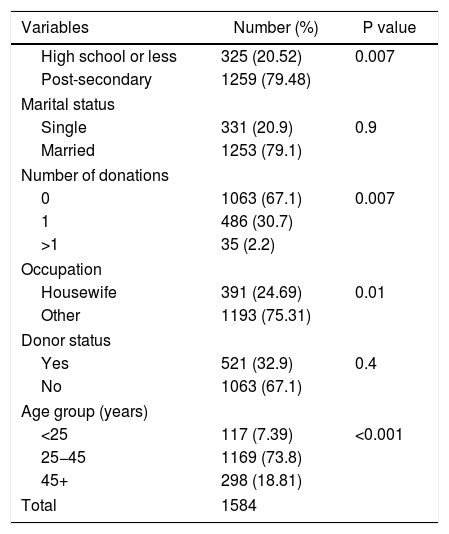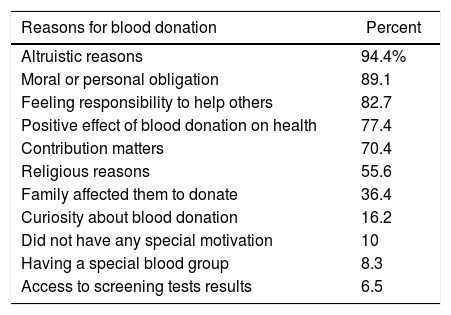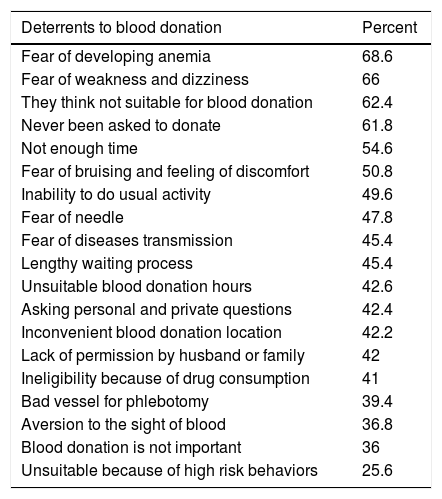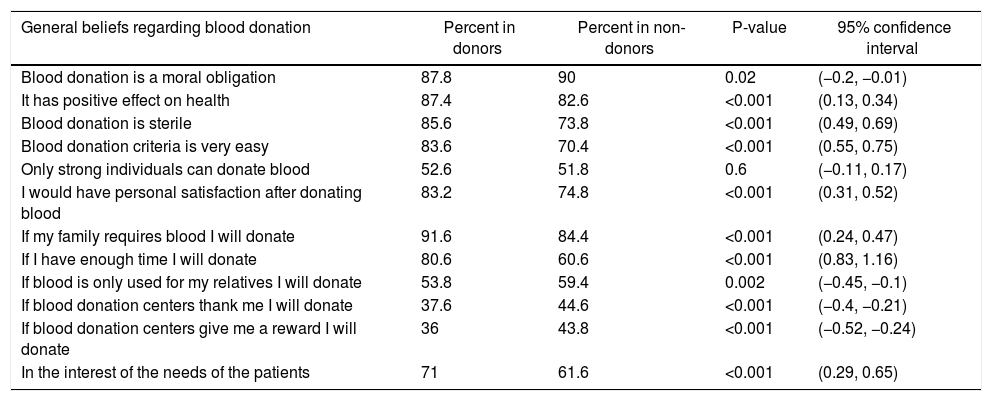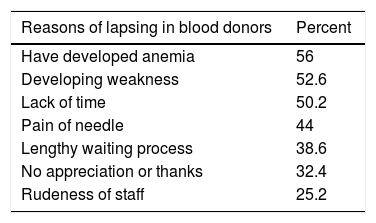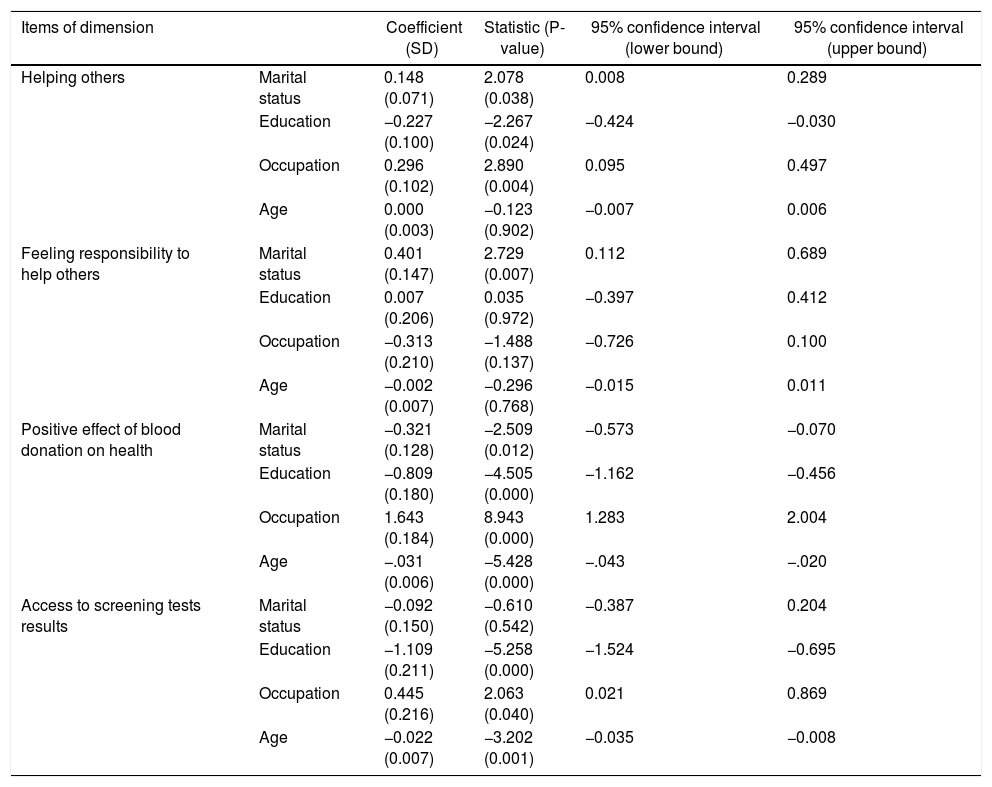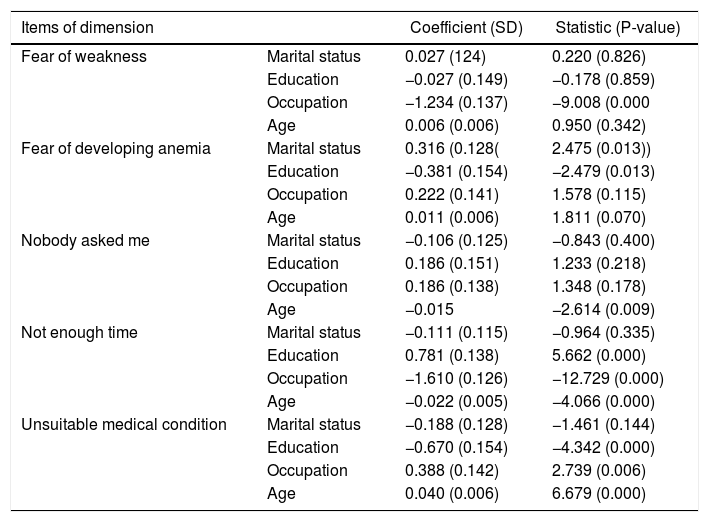The under-representation of women in blood donation can lead to blood shortages. We aimed to determine the factors, which encourage or impede blood donations in women. The findings can help us in designing effective recruitment strategies that could encourage women to donate blood to cover the patients’ needs. This cross-sectional study was conducted in Shiraz, Iran, from the 1st of January 2017 to the 1st of August 2017 on women aged 18–60 years old. The demographic characteristics of the participants, the reasons that motivate blood donors and the factors that discourage non-donors were surveyed. Reasons for lapses in donors were also mentioned. The most frequent reasons for blood donation were altruistic causes (94.4%), moral and personal obligations (89.1%), the feeling of responsibility (82.7%), and awareness of the positive effects on their health (77.4%). The most common deterrents in non-donors were fear of developing anemia (68.4%) or weakness and dizziness (66%), unsuitability due to certain medical conditions (62.4%), and lack of a situation in which they were asked to donate blood (61.8%). Although altruistic reasons are the chief motivating factors for women to donate blood, the overall female contribution in blood donation remains low. Therefore, it is necessary to take measures aiming at informing women about the importance of blood donation and to reduce fears based on misinformation. Confidence in the blood donation organization must be a major consideration in future recruitment strategies to reassure women about the safety of blood donation.
The blood transfusion centers are currently faced with a continuous blood shortage due to insufficient blood donation. The service relies fully on the willingness and co-operation of the general population, but a number of factors significantly hinder this. Seasonal and holiday variations, short half-life of the blood products, limited number of suitable individuals for donation, strict criteria for donor selection, and sensitive screening tests that may deter potential donors are some of these factor.1,2
Non-paid voluntary blood donors support the Iranian blood transfusion service.3,4 Collectively, the number of donors is high, resulting in a collection rate of 27 units per 1000 populations. However, the majority of blood supply (94.8%) was collected from male donors. The predominance of male blood donors shows that the past recruitment strategies have been successful for men, whereas female donors supplied only 5.2% of the blood. Under-representation of women was even more prominent amongst regular donors. Therefore, the overall figures indicate that almost half of the potential blood donor population had low contribution to blood donation; consequently, this could cause blood shortage. In comparison, women in European countries contribute to 40–50% of the blood supply, 33% in Greece, and 10% in Turkey.5–7 Another study reported a similar or even higher contribution of female first-time donors in blood donation, but lower participation levels in regular donation in reproductive-aged women. However, the contribution of women aged over 45 years was at similar levels.7–10,12,13
Previous studies also reported that altruism, community responsibility, or the belief that blood donation is a valuable act were found to be the main underlying motives in women, whereas social pressure and personal obligation were the main motives in men.14–16 In addition, the deferral rates of women were higher than men because of medical unsuitability, anemia, pregnancy, breast-feeding, low body weight, low deposits of iron, low blood pressure, and other health problems.6,7,17 Given the current under-representation of female blood donors in Iran, this study aims to determine the underlying factors which have influenced blood donation in women.
Materials and methodsThis was a cross-sectional survey of women aged 18–60 years old from January 1st 2017 to August 1st 2017 in Shiraz, Iran. The sample size was calculated through probability proportional size sampling method.18 The sample size was calculated 1554 by alpha: 0.05, power of 80%, the proportion of 39.1%, and margin of error of 0.3.5%. For increased sensitivity, 1584 participants was selected.
The sample was selected by the random clustering method. The trained interviewers referred to the houses at different times of the day and asked the woman meeting the age criteria to complete a questionnaire. One hundred twenty one women did not participate in this study; the reasons were the lack of time (71, 57.9%), being busy (40,33%), and a lack of willingness to participate (11,9.1%). If a woman declined to participate, or there was nobody present at home, another woman living in the next home in that cluster was replaced.
Fars IBTO Research Committee approved the research protocol (No: P22 01.02.2017). A researcher-made questionnaire was used based on a previous study.19,20 The questionnaire was anonymous and the answers were kept confidential. The Kuder-Richardson’s alpha coefficient for this questionnaire was 0.703. The Cranach’s alpha for the entire 51-item scale was 0.703. This was in an acceptable range of reliability, greater than 0.7. The construct validity was calculated by confirmatory factor analysis (CFA) using statistical package analysis of moment structures (AMOS.21). Several goodness-of-fit indices were examined to assess the fit of the model, which were in the acceptable range. The Chi-square relative to its degree of freedom X2/DF, Root Mean Square Error of Approximation (RMSEA), Comparative Fit Index (CFI),and Tucker Lewis index (TLI) were 2.726,0.068, 0.931, and 0.918, respectively.
The questionnaire consisted of questions concerning:
- 1
Demographic characteristics (sex, age, marital status, education, and occupation).
- 2
Blood donation history in both donors and non-donors (previous number of donations, their willingness for future blood donation).
- 3
Donors’ reasons for donating (12 questions).
- 4
Deterrent factors in non-donors (20 questions).
- 5
Personal beliefs or opinions regarding blood donation in blood donors and non-blood donors (12 questions).
- 6
Reasons for non-donation in blood donors (7 questions).
Each question was rated on a scale from 5 (“completely agree”) to 1 (“completely disagree”). Then, the mean score for each item was calculated. All subjects were required to answer questions concerning their general beliefs about blood donation. Donors answered questions regarding their reasons for blood donation and their reasons for refraining from donation, whereas non-donors responded to the questions regarding reasons for non-donation. Normality of qualitative variables was tested by Shapiro–Wilk test. Chi square test, General Linear Model regression and Pearson Correlation tests were used for statistical analyses in SPSS version 21.0 (SPSS, Inc., Chicago, IL, USA). Assumption of Linear regression was checked and confirmed. P-value ≤0.05 was considered statistically significant.
ResultThe mean age of the participants was 35.82 ± 8.79 years old. The demographic characteristics of the participants are shown in Table 1. Overall, 521 participants (32.9%) who had a history of previous blood donation were classified as donors, and 1063 (67.1%) who did not have a history of blood donation were classified as non-donors (Table 1). In total, the mean number of blood donations in donors was 0.99 ± 0.38. The education level of blood donors was more than non-donors (P = 0.01). Blood donors had a more professional job compared to non-donors (P < 0.001). The mean age of blood donors was more than non-donors (P < 0.001).
Demographic characteristics of the participants.
| Variables | Number (%) | P value |
|---|---|---|
| High school or less | 325 (20.52) | 0.007 |
| Post-secondary | 1259 (79.48) | |
| Marital status | ||
| Single | 331 (20.9) | 0.9 |
| Married | 1253 (79.1) | |
| Number of donations | ||
| 0 | 1063 (67.1) | 0.007 |
| 1 | 486 (30.7) | |
| >1 | 35 (2.2) | |
| Occupation | ||
| Housewife | 391 (24.69) | 0.01 |
| Other | 1193 (75.31) | |
| Donor status | ||
| Yes | 521 (32.9) | 0.4 |
| No | 1063 (67.1) | |
| Age group (years) | ||
| <25 | 117 (7.39) | <0.001 |
| 25−45 | 1169 (73.8) | |
| 45+ | 298 (18.81) | |
| Total | 1584 | |
The main motivating factors behind blood donation were found to be altruistic reasons (94.4%), moral and personal obligation (89.1%), a feeling of responsibility to help people (82.7%), and awareness of the positive effect of blood donation on their health (77.4%) (Table 2). The most common reasons, which had deterred non-donors, were the fear of developing anemia (68.4%), fear of weakness and dizziness (66%), unsuitable medical conditions (62.4%), or lack of a situation in which they were asked to donate (61.8%) (Table 3). General beliefs about blood donation in donors and non-donors are compared in Table 4). The main reasons for non-donation in donors were fear of developing anemia (56%), developing weakness (52.6%), and lack of time (50.2%) (Table 5). The overall knowledge and awareness concerning blood donation criteria were more apparent in donors compared with non-donors (82% vs. 44%). The overall knowledge and awareness concerning blood donation criteria were also greater amongst married participants, those with higher education, and those with professional occupations. About 89.2% of the participants (donors and non-donors) considered blood donation as a vital act to save lives (87.8% donors vs. 90% non-donors). For blood donation, 39.6% of the participants believed that they must receive incentives (36% of donors vs. 43.8% of non-donors) and 42.3% expected to be appreciated for their donation (37.6% of donors vs. 44.6% of non-donors). In addition, 82.7% of the donors were willing to donate blood if one of their family members ask them to do so (91.6% of donors vs. 84.4% of non-donors). Estimation parameters in repeated measures for evaluating motivational factors and deterrents and demographic characteristics of donors and non-donors are showed in Tables 6 and 7.
Self-explanatory: frequent reasons for blood donation.
| Reasons for blood donation | Percent |
|---|---|
| Altruistic reasons | 94.4% |
| Moral or personal obligation | 89.1 |
| Feeling responsibility to help others | 82.7 |
| Positive effect of blood donation on health | 77.4 |
| Contribution matters | 70.4 |
| Religious reasons | 55.6 |
| Family affected them to donate | 36.4 |
| Curiosity about blood donation | 16.2 |
| Did not have any special motivation | 10 |
| Having a special blood group | 8.3 |
| Access to screening tests results | 6.5 |
Self-explanatory: the most common deterrents to blood donation.
| Deterrents to blood donation | Percent |
|---|---|
| Fear of developing anemia | 68.6 |
| Fear of weakness and dizziness | 66 |
| They think not suitable for blood donation | 62.4 |
| Never been asked to donate | 61.8 |
| Not enough time | 54.6 |
| Fear of bruising and feeling of discomfort | 50.8 |
| Inability to do usual activity | 49.6 |
| Fear of needle | 47.8 |
| Fear of diseases transmission | 45.4 |
| Lengthy waiting process | 45.4 |
| Unsuitable blood donation hours | 42.6 |
| Asking personal and private questions | 42.4 |
| Inconvenient blood donation location | 42.2 |
| Lack of permission by husband or family | 42 |
| Ineligibility because of drug consumption | 41 |
| Bad vessel for phlebotomy | 39.4 |
| Aversion to the sight of blood | 36.8 |
| Blood donation is not important | 36 |
| Unsuitable because of high risk behaviors | 25.6 |
General beliefs regarding blood donation in donors and non-donors.
| General beliefs regarding blood donation | Percent in donors | Percent in non-donors | P-value | 95% confidence interval |
|---|---|---|---|---|
| Blood donation is a moral obligation | 87.8 | 90 | 0.02 | (−0.2, −0.01) |
| It has positive effect on health | 87.4 | 82.6 | <0.001 | (0.13, 0.34) |
| Blood donation is sterile | 85.6 | 73.8 | <0.001 | (0.49, 0.69) |
| Blood donation criteria is very easy | 83.6 | 70.4 | <0.001 | (0.55, 0.75) |
| Only strong individuals can donate blood | 52.6 | 51.8 | 0.6 | (−0.11, 0.17) |
| I would have personal satisfaction after donating blood | 83.2 | 74.8 | <0.001 | (0.31, 0.52) |
| If my family requires blood I will donate | 91.6 | 84.4 | <0.001 | (0.24, 0.47) |
| If I have enough time I will donate | 80.6 | 60.6 | <0.001 | (0.83, 1.16) |
| If blood is only used for my relatives I will donate | 53.8 | 59.4 | 0.002 | (−0.45, −0.1) |
| If blood donation centers thank me I will donate | 37.6 | 44.6 | <0.001 | (−0.4, −0.21) |
| If blood donation centers give me a reward I will donate | 36 | 43.8 | <0.001 | (−0.52, −0.24) |
| In the interest of the needs of the patients | 71 | 61.6 | <0.001 | (0.29, 0.65) |
Estimation parameters in repeated measurement for evaluating motivational factors with demographic data in donors.
| Items of dimension | Coefficient (SD) | Statistic (P-value) | 95% confidence interval (lower bound) | 95% confidence interval (upper bound) | |
|---|---|---|---|---|---|
| Helping others | Marital status | 0.148 (0.071) | 2.078 (0.038) | 0.008 | 0.289 |
| Education | −0.227 (0.100) | −2.267 (0.024) | −0.424 | −0.030 | |
| Occupation | 0.296 (0.102) | 2.890 (0.004) | 0.095 | 0.497 | |
| Age | 0.000 (0.003) | −0.123 (0.902) | −0.007 | 0.006 | |
| Feeling responsibility to help others | Marital status | 0.401 (0.147) | 2.729 (0.007) | 0.112 | 0.689 |
| Education | 0.007 (0.206) | 0.035 (0.972) | −0.397 | 0.412 | |
| Occupation | −0.313 (0.210) | −1.488 (0.137) | −0.726 | 0.100 | |
| Age | −0.002 (0.007) | −0.296 (0.768) | −0.015 | 0.011 | |
| Positive effect of blood donation on health | Marital status | −0.321 (0.128) | −2.509 (0.012) | −0.573 | −0.070 |
| Education | −0.809 (0.180) | −4.505 (0.000) | −1.162 | −0.456 | |
| Occupation | 1.643 (0.184) | 8.943 (0.000) | 1.283 | 2.004 | |
| Age | −.031 (0.006) | −5.428 (0.000) | −.043 | −.020 | |
| Access to screening tests results | Marital status | −0.092 (0.150) | −0.610 (0.542) | −0.387 | 0.204 |
| Education | −1.109 (0.211) | −5.258 (0.000) | −1.524 | −0.695 | |
| Occupation | 0.445 (0.216) | 2.063 (0.040) | 0.021 | 0.869 | |
| Age | −0.022 (0.007) | −3.202 (0.001) | −0.035 | −0.008 | |
Estimation parameters in repeated measurement for evaluating deterring Items demographic in non-donors.
| Items of dimension | Coefficient (SD) | Statistic (P-value) | |
|---|---|---|---|
| Fear of weakness | Marital status | 0.027 (124) | 0.220 (0.826) |
| Education | −0.027 (0.149) | −0.178 (0.859) | |
| Occupation | −1.234 (0.137) | −9.008 (0.000 | |
| Age | 0.006 (0.006) | 0.950 (0.342) | |
| Fear of developing anemia | Marital status | 0.316 (0.128( | 2.475 (0.013)) |
| Education | −0.381 (0.154) | −2.479 (0.013) | |
| Occupation | 0.222 (0.141) | 1.578 (0.115) | |
| Age | 0.011 (0.006) | 1.811 (0.070) | |
| Nobody asked me | Marital status | −0.106 (0.125) | −0.843 (0.400) |
| Education | 0.186 (0.151) | 1.233 (0.218) | |
| Occupation | 0.186 (0.138) | 1.348 (0.178) | |
| Age | −0.015 | −2.614 (0.009) | |
| Not enough time | Marital status | −0.111 (0.115) | −0.964 (0.335) |
| Education | 0.781 (0.138) | 5.662 (0.000) | |
| Occupation | −1.610 (0.126) | −12.729 (0.000) | |
| Age | −0.022 (0.005) | −4.066 (0.000) | |
| Unsuitable medical condition | Marital status | −0.188 (0.128) | −1.461 (0.144) |
| Education | −0.670 (0.154) | −4.342 (0.000) | |
| Occupation | 0.388 (0.142) | 2.739 (0.006) | |
| Age | 0.040 (0.006) | 6.679 (0.000) | |
Globally, about 28% of blood donation is collected from women; however, the female contribution in 16 counties out of 119 is less than 10%.3,4 Every year, about 2 million blood units are collected in Iran to cover the transfusion needs, but only 5.2% of blood is collected from female donors.4 Therefore, understanding the motivational factors behind blood donation in women is essential. In our study, the most frequent motivating factor behind blood donation in women was altruistic reasons (94.4%). These findings were consistent with previous studies that reported altruism as the main reason for blood donation by women.13,18,21
We found that 77.4% of women donated blood for its positive effect on their health. In a previous study in Iran, the main motivation of 38.6% of donors (26% of first-time donors and 31% of regular donors) was its positive effect on health. In another study, about 9% of individuals donated blood to improve their health.22 Correspondingly, the same reasons were also confirmed in a number of previous researches.23,24 Some individuals believed that blood donation could decrease blood concentration, the level of cholesterol, the level of blood sugar, the level of blood pressure, and numbness in the hands and feet. Some donors assumed blood donation as a religious duty. The establishment of special conditions that invite women to donate blood during religious occasions and provide suitable facilities results in a positive experience which could encourage more women to donate blood on a regular basis. Particular emphasis on the need for continuous donation throughout the year is essential and this can only be achieved if the donors’ comfort and needs are also respected.18,24–26
In addition, 6.5% of blood donors believed that could donate blood for access to screening test results. In another study in Iran, 3.7% of donors donated blood for this reason.18 Education of donors regarding the windows period of blood borne diseases and reminding them that they should not donate blood for HIV seeking is essential. It shows the importance of blood donor selection for deferring high-risk blood donors. Informing blood donors should refer to voluntary counseling and testing centers for performing free screening tests.
Besides, altruistic motivations were greater amongst older donors, while blood donation for the positive effects on health was higher amongst younger donors. Another survey in Iran stated that altruistic motives were higher in younger donors.18,24 Currently, it appears that there is a need to educate and encourage younger women to consider blood donation as a worthwhile altruistic act that can save the patients’ lives.
Moreover, 89.2% of women considered blood donation as a positive act, but only 18.7% of women (45.5% of donors and 5.1% of non-donors) stated that they were willing to donate blood in the future. In addition, 38.9% stated that they would donate regularly. In this study, 88.6% of the women stated that they would be willing to donate if their close relatives require it. A considerable finding of this study was that the non-donor women agreed more strongly on the importance of blood donation compared with donors (90.4% vs. 87.8%). This highlights the fact that although these women fully recognize the importance of blood donation, there are a number of factors that hinder them, including medical ineligibility, misguided beliefs or fears.
The most frequent barriers in blood donation participation were shown to be the fear of developing anemia, fear of weakness, dizziness, unsuitable medical condition, or not being asked to donate. Women at reproductive age are prone to iron depletion because of menstrual blood loss, pregnancy, and breast-feeding. Blood donation may also cause iron depletion.27 Previous reports showed iron depletion in first-time women donors, those with a history of two donations in a year and those with 4 donations in a year.13,27–29 In previous studies, the main reasons for women’s deferral were anemia or iron deficiency and medical unsuitability for blood donation.12,11,17,30–32 Educating the women, supporting them with supplements during child- bearing ages and pregnancy and also providing suitable medical condition for donation can help to solve these problems.7,10,13,20 Since the year 2000, in Iran, female donors have received 30 iron supplement tablets following donation to prevent iron deficiency.18
Developing anemia was the most deterrents' factors in lapsed donors. This shows the importance of education donors regarding the consumption of iron-rich diet and iron supplement tablets following blood donation. Low body weight, lack of time for blood donation due to a busy lifestyle, difficulties to access the donation site, fear of needles, fainting, disease transmission, weakness, and even infertility were all considered as other potential deterrents to blood donation.10,19,33
Furthermore, 62.4% of females think they were not suitable for blood donation. In a previous study also showed that about one -third of individuals taught blood donation may harm them.25,34 Therefore, it is necessary to educate individuals regarding blood donation criteria. In addition, females must be informed that the medical eligibility of them were surveyed before donation by physicians. If physicians make sure that blood donation do not harm donors, the blood donors only will have permission to donate blood. Therefore, decreasing the misconceptions and the reassurance of women about blood donation safety can increase desire for blood donation. It seems no organized recruiting activities have been made to promote women to donate blood. So, it is necessary to develop training programs to increase women’s attitude toward blood donation.
The education level of blood donors' was higher than non-donors. In addition, blood donors had more professional jobs. It seems that highly educated women have better access to social activities. In addition,educated women may have more information regarding the importance of blood donation, better socio-economical status, and better access to healthier lives.35
Previous studies also showed blood donation was related to education, income, and occupation.36,37 Another study also showed that education and information regarding the importance of blood donation had a major role in blood donation decision.38 In Iran, the education level of women is high. It is estimated that about 60% of university students and 68% of university educated participants were women.39 So, it seems that women education is not enough to encourage them to donate blood. The recruiting efforts must be performed to create more motives in Iranian women to participate in blood donation, like other social activities.
In addition, most of the participants also stated that they did not expect any incentive in return for their voluntary donations. In addition, we showed that 32.4% of donors did not return for blood donation because they did not receive any appreciation for their act. Therefore, a message of thanks that appreciates and confirms the lifesaving role of donors may help improve the return rates. Using communication and advertisement methods (brochures, text messaging, telephone calls, mobile applications, social network, email, newsletter, radio, and television) to target this population is also beneficial.25
LimitationsThe study relied on the honesty of the participants when answering the questions and it is possible that they may choose a socially acceptable motivation instead of their real motivation. In addition, we could not compare the motivations of donors according to donation status (first time, lapsed, and regular donor) because of the low participation rate of women in blood donation. Moreover, we asked them about their willingness to donate blood in the future. In spite of their positive response, the donors may not return in the future.
ConclusionUnder-representation of women in blood donation revealed the weakness of Iran’s blood transfusion services in designing effective recruitment strategies. Increasing in the level of awareness of women, who comprise about 50% of society must be considered as a topmost priority of blood donation centers. In our study, however, the most frequent motives for women to donate were altruistic reasons and moral obligations. It is evident that the donor selection criteria for women such asacceptable level of hemoglobin, suitable interval of blood donation, acceptable level of blood donation in a year, the restrictions due to medical factors, and other conditions related to reproductive agecan limit the female blood donor population. Understanding the main motives and deterrents for women for blood donation can provide an essential insight into thespecific problems, needs, and ways of encouraging in female individuals. Women must be educated about the importance of blood donation in saving lives and must be reassured about the safety and benefits of the act. In addition, the community and religious leaders must do emphasize the blood donation for females, too.
Conflicts of interestThe authors declare no conflicts of interest.
The authors would like to thank Dr SaharHosseini and Medipress group and SIMR Co. for scientific and linguistic editing of this paper.


